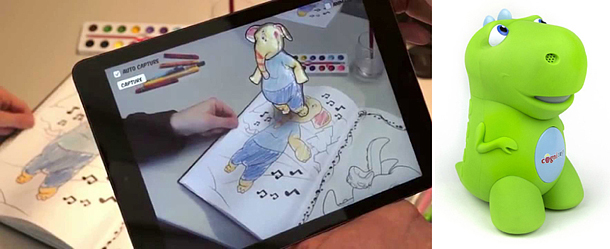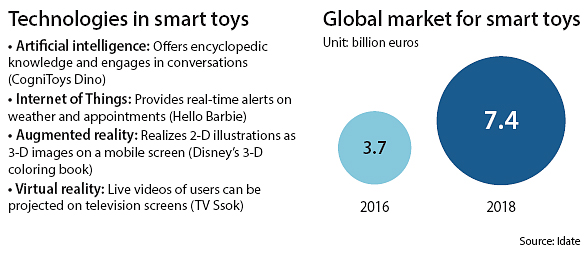When dolls come with Wi-Fi, machine learning

Disney’s 3-D coloring book, left, and CogniToys’ Dino are both “smart toys” powered by advanced technology. [EACH COMPANY]
Dino is currently one of the hottest stuffed animal toys in the United States.
The company that makes it, CogniToys, derives its name from “cognitive toy.” Dino is actually embedded with IBM’s powerful artificial intelligence system known as Watson that can deliver encyclopedic information and interact with humans.
Such toys that incorporate artificial intelligence technology or network technology like the Internet of Things fall under the category of “smart toys.”
What differentiates them from conventional toys is the micro-sized computer chip that enables them to engage in two-way communication with people to a level not possible before.
According to ICT consulting firm Idate, the global market for smart toys was 3.7 billion euros ($4.4 million) last year and is projected to double by next year to 7.4 billion euros.
The global market is already seeing wide varieties of smart toys. Mattel’s Hello Barbie has a Wi-Fi connection and microphone that allows it to “talk” to people and give them timely information on things like the weather.
The doll can keep track of users’ schedules and alert them about appointments. If a person says he or she arrived in New York, Hello Barbie can even ask, “What do you like best in New York?”

Lego’s Mindstorms EV3 robot comes with a full set of instructions, programming tools and missions, with modules and touch sensors that let children code how the robots will move - and hopefully get them interested in coding.
There are several explanations for the rise of smart toys. First, children of this generation have been born into an era of communication devices like smartphones and tablets and therefore are much more used to playing with them than previous generations.
Parents, too, are looking for new and fun sources of education for their kids. Programming skills and knowledge in computer science have emerged as necessary tools in this age of fast-paced technology development.
Smart toys like the EV3 can satisfy the demand to familiarize children with coding. These products also attract so-called kidults, grown-ups who enjoy playing with toys that incorporate the latest technology.
“Analogue toy manufacturers have been struggling for some time now in the digital age,” said John Lee, an analyst at Hyundai Research Institute. “Their recent set of efforts can be interpreted as a way for them to reverse the situation through smart toys.”
Having witnessed their potential, Korean companies are jumping into the market as well. KT, the country’s second-largest telecommunications company, recently released a “TV Ssok” service where users can film themselves on smartphones and see the images projected live on a television screen.
The Korean start-up Smart Wellness developed Cubroid, cube blocks designed for coding education. The blocks, which have surfaces similar to Legos, can be attached to one another, and users can program them to control their movements.
BY LEE CHANG-KYUN [song.kyoungson@joongang.co.kr]










with the Korea JoongAng Daily
To write comments, please log in to one of the accounts.
Standards Board Policy (0/250자)